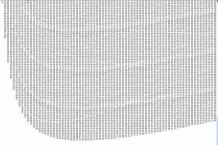
exploring the undesigned
intelligence of the numberverse
First published March 3
Revised March 12, 2008
Read about Fermat's factorization method.
Part 2
The Magic Square of Addition: A Deterministic Algorithm to test compositeness.
I recently "found" two perfect square rules that were formative in formulating this algorithm. They are discussed in:
Q-Paired Primes: Two Interesting Rules.
It's sometimes worth stating the obvious in case it gets overlooked. The difference between any two adjacent perfect squares is always an odd number. The difference in the interval between two adjacent perfect squares is always 2. If you put these two basic facts together, you see that through subtraction of perfect squares you will be able to derive every odd number in the number line except for 1.
If you're not sure about this, simply look at the lists of perfect squares on this site. These lists contain three columns of data: the root of the perfect square, the perfect square itself, and the interval between the perfect square and the previous one. This interval is the difference or product of perfect square subtraction.
In number theory, the fundamental theorem of arithmetic (or unique-prime-factorization theorem) states that every natural number greater than 1 can be written as a unique product of prime numbers.
So, for example, the unique prime factorization of 999 is: 3 * 3 * 3 * 37.
We can now state a "fundamental theorem of perfect square subtraction" such that every odd natural number is the subtractive product of two, and only two, adjacent perfect squares.
You will see that to obtain through subtraction, say, 999, you will need to subtract some relatively large perfect squares. The unique perfect square subtraction that produces 999 is: 249001- 250000.
Incidentally, the formula for deriving any odd number with perfect square subtraction can be expressed this way:
N = (Int(N / 2) +1) ^ 2 - Int(N / 2) ^ 2
In some recent research, I spent a lot of time looking at the behavior of fixed values added to perfect squares - in particular the occurrence of primes at regular paired intervals. You can read about it in the following columns:
Q-Paired Primes: The Investigation Continues...
What are Biquadratic Paired Primes?
While this work produced some interesting results, I had been overlooking a far more fantastic and fertile field of investigation: subtracting fixed values from perfect squares.
|
Using the algorithm with a fixed number of rows and separating the minus-square multiples and nonmultiples produce these distinctive distributions.
*Numbers that are evenly divisible by their respective minus-squares (see main article). Download XLS file (642KB) |
|
2500 Years Ago, the Greeks discovered a method for determining the longest measure that equally divides two line lengths - a method that uses only subtraction... |
|||||||||||||||||||||||||||||||||||||||||||||||||||||||||||||||||||||||||||||||||||||||||||||||||||||||||||||||||||||||||||||||||||||||||||||||||||||||||||||||||||||||||||||||||||||||||||||||||||||||||||||||||||||||||||||||||||||||||||||||||||||||||||||||||||||||||||||||||||||||||||||||||||||||||||||||||||||||||||||||||||||||||||||||||||||||||||||||||||||||||||||||||||||||||||||||||||
Named after Euclid, who first recorded it, the Euclidean algorithm is one of the oldest and greatest algorithms known to mathematics. Its simplicity and effectiveness still set a standard for modern mathematicians. The subject of this topic is not the Euclidean algorithm - you can read about it here - although it is certainly an inspiration for this discussion about a deceptively simple but powerful method for generating composite numbers using the subtraction of perfect squares. The method is also a means for determining primality by elimination: a technique that does not require trial division or modular arithmetic. The Basic Idea The initial idea comes from the following observation: The number that immediately precedes a perfect square is never prime with the single exception of 4 - 1 = 3.
It seemed possible that if this rule held for PS-1, it might hold for PS-N, where N is another perfect square - just maybe.... The huge surprise is that the rule holds true for every perfect square. In every case - with the important and irregular exception of the first subtraction (the first row in the table), which we will talk about in a moment - the numbers produced by subtraction of perfect squares are composite numbers:
For clarity, let's refer to the perfect squares that are being subtracted as "minus-squares" - so if 16 - 9 = 7 and 25 - 9 = 16, the minus-square is 9 in both cases:
Now notice that the perfect squares in the 1st, 3rd, 5th, 7th, 9th, and 11th columns are shifting up each time by one square. That's simply because the minus-square cannot be greater than the perfect square. So when subtracting 4, the first perfect square to be considered is 9; when subtracting 9, the first perfect square to be considered is 16, and so on. The first row The first row is created by the first subtraction: the minus-square is one square smaller than the perfect square: 4-1, 9-4, 16-9, 25-16, 36-25, 49-36, 64-49, and 81-64. Let's look a little harder at what's happening in the first-row results:
It turns out that 9 - 4 = 5 is a prime number of course. In other words, this is a single exception (like 4 - 1 = 3) to the otherwise compositeness of all perfect squares minus 4. Similarly, 36 - 25 = 11 and 64 - 49 = 12 are also exceptions to the otherwise uniform compositeness of their respective columns. However 25 - 26 = 9 and 81 - 64 = 15 are definitely composite. There are no exceptions to compositeness in these columns. If we were hoping to find some kind of transparent pattern to the exceptions we will be disappointed. But we should not give up too easily.... Because it so happens that this table has a very nice property - the property of repetition or reoccurrence....
Thus we have a two-part test for primality:
That's it in a nutshell. You now have a complete algorithm for determining compositeness and primality that requires neither division nor exponentiation. Some open questions One big open question is how many rows does the table need to have to ensure that the compositeness of the first-row nonprimes can be proved by prior occurrence. This is important as it determines the efficiency of the algorithm for proving primes. The number of rows needed to prove composites progressively increases, from about 20 rows for primes under 1000, to about 50 rows for primes under 5000, to about 100 rows for primes under 10000. But this is very approximate, and does not take into account that the row depth requirement actually decreases almost geometrically after the first few columns. This will be a subject of the next column on this topic. However, if your aim is to safely generate the largest number of composites, you can go as deep as you can in terms of number of rows. You can be assured that every number generated will be composite except those that appear in the very first row. The arithmetic operations are so simple that, even though the numbers rapidly become very large as the row depth increases, the performance impact is not even a consideration. There are a few complexities that I didn't mention. All composite numbers appear unless they are alternate multiples of 2 - for example: 6, 10, and 14 do not. Multiples of 4 do appear - for example, 8, 12, and 16. The reason for this is not that simple to explain and may be related to the concept of quadratic reciprocity. This needs to be researched. Another feature of the table are the factor "rays" (or curves) that emanate from the top left corner and traverse without breaks through the table at various angles. Shown in orange below, these are numbers that are evenly divisible by their respective minus-squares - thus, 9 is a factor of 27, 72 and 135. Notice that the interval between multiples of a perfect square increase by row (or square) with each successive column (or minus-square).
Well, all that remains is to make the code available to demonstrate these findings... Enjoy! All you have to do is to select everything in the text area above and drag or copy it to the Excel Visual Basic Editor, dropping it into the VBAProject ThisWookbook object. Save and exit the file. Then reopen it, and the code will autostart providing that your macro security is not high or very high. Part 2: A Deterministic Test for Compositeness Using Perfect Squares... |
|||||||||||||||||||||||||||||||||||||||||||||||||||||||||||||||||||||||||||||||||||||||||||||||||||||||||||||||||||||||||||||||||||||||||||||||||||||||||||||||||||||||||||||||||||||||||||||||||||||||||||||||||||||||||||||||||||||||||||||||||||||||||||||||||||||||||||||||||||||||||||||||||||||||||||||||||||||||||||||||||||||||||||||||||||||||||||||||||||||||||||||||||||||||||||||||||||

